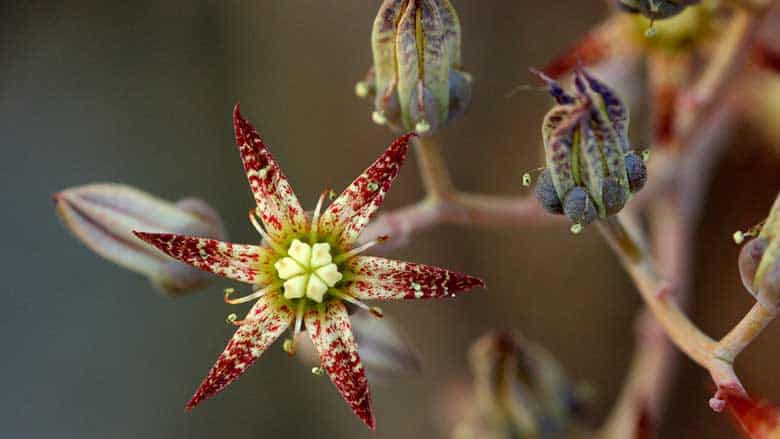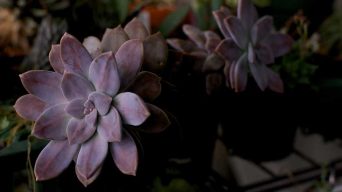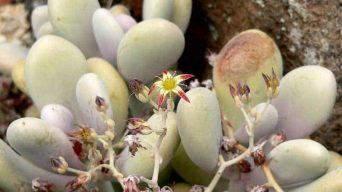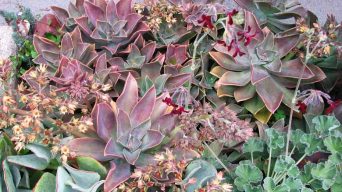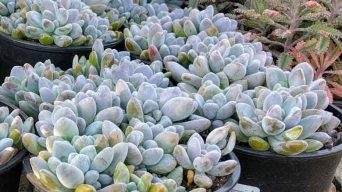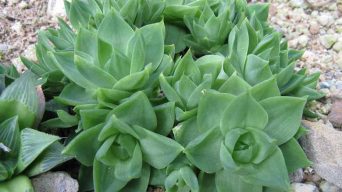The Graptopetalum rusbyi succulent is a unique and interesting plant to have in your home.
Its small size and beautiful leaves make it an excellent houseplant or outdoor garden addition.
They’re easy to maintain and perfect for those who don’t have a green thumb!
If you want to learn everything you need to know about caring for and propagating Graptopetalum rusbyi plants by yourself, this is the article for you!
Overview
Graptopetalum rusbyi is a species in the genus Graptopetalum that belongs to the Crassulaceae family and is native to Arizona and Mexico.
Graptopetalum rusbyi are perennial succulent plants that often produce low-growing rosettes of leaves and a flower spike in the springtime.
It has leaves up to 2 inches (5 cm) long and up to 0.6 inches (1.5 cm) wide in green, red, or violet colors.
The rosettes grow 4 inches (10 cm) across at their widest point but generally stay very small overall, with lengths usually around 1 inch (.4 m).
It flowers profusely in the springtime when 6 to 8-inch tall stalks produce clusters of yellowish-white petals speckled with darker colors toward the center, which lengthen out to form a stalk.
It has been known by several other names, including:
- San Francisco River Leatherpetal
- Leatherpetals
- Leather Petals
How To Care for Graptopetalum Rusbyi
Graptopetalum rusbyi care is relatively easy for a succulent or cacti.
The following are the essential things to consider to care for the Graptopetalum rusbyi plant properly.
Sun Exposure & Light Requirements
The Graptopetalum rusbyi plant is a full sun to partial shade succulent.
The best sunlight for Graptopetalums occurs in the morning and evening hours, but they can also take direct midday light.
These succulent plants are better suited outdoors than indoors.
Outdoors, Graptopetalums prefer an open space where it gets six hours of sunlight per day.
Provide shade during the hottest parts of summer by positioning them between two larger shrubs with taller trees above, blocking much of the heat-producing rays from reaching your Graptopetala’s foliage.
Watering Requirements
The Graptopetalum rusbyi succulent plant should be watered when the soil is dry.
If you are unsure whether or not it needs a drink, touch the soil. If it is moist, wait a while before watering again.
When you decide to water your Graptopetalum plant, ensure it is thoroughly wet before allowing the pot to drain completely.
Do not water your Graptopetalum plant when the soil is damp, as this will lead to overwatering and root rot.
Soil Requirements
Graptopetalum rusbyi prefers a soil with excellent drainage.
It’s important to avoid using heavy soils, clay-rich soils, or those too coarse for the Graptopetalum plant to grow in without difficulty.
Any potting mix will generally do as long as it is not clay-based and drains quickly.
Some examples include:
- Succulent/cactus mix
- All-purpose potting soil with perlite added for better drainage (these usually come premixed).
- Coir fiber substrate mixed with sand and peat moss has excellent drainage while retaining moisture.
Temperature and Humidity Requirements
The Graptopetalum rusbyi plant prefers warmer and drier conditions.
Most Graptopetalums should be grown in temperatures between 65°F to 80°F with a relative humidity of 50%.
If the temperature is going to fluctuate, keep it close to 70°F.
The lowest that most Graptopetalum plants will tolerate is 45°F or slightly less than 40% relative humidity levels.
If you provide your Graptopetalum rusbyi plant with good drainage and temperatures between 65°F-80°F, then cool nights of 45°F-50%, you should not have any problems!
Fertilizing
Graptopetalums require less fertilizer than many other succulent plants.
The Graptopetalum rusbyi typically should be watered with a diluted fertilizer during the growing season.
A water-soluble balanced fertilizer at half strength is usually adequate for your Graptopetalum rusbyi plant’s needs.
DO NOT use any type of chemical-based pesticide or fungicide on Graptopetalums!
They are very sensitive to these chemicals and can cause severe damage if they come into contact with them while still alive in their pots/soil!
These types of pesticides will also harm you, so always wear gloves when handling them.
Potting and Repotting
If you want to grow Graptopetalum rusbyi plants in containers, it is recommended that you use a porous soil with plenty of organic material for drainage.
It also needs good draining pots and ceramic or plastic potting mix without any fertilizer.
You should use pots at least 12 inches in diameter or bigger if you want to grow the Graptopetalum rusbyi plant for long periods.
Fill the bottom third of the pot with gravel, and then add soil mix on top before putting your Graptopetalums into it.
If you want to transplant Graptopetalum rusbyi plants, fill your new container with soil and carefully place the Graptopetalums on top.
Plant them at least an inch below their original planting depth and water until moist but not wet.
Pruning
Pruning helps your Graptopetalum rusbyi to grow bushier and healthier by removing dead leaves or damaged areas.
You can prune from any time of year, but it is best late winter/early spring before new growth starts for your Graptopetalum plant not to get shocked when exposed to heat after being dormant all winter.
To know what part of your Graptopetalum rusbyi plant needs to be trimmed, simply look at it critically; if it looks like it’s going brown, then that probably is a good area that needs to be removed.
Cut off about two inches below where you want the cut, and then wait until next season (or sooner) for more green shoots to sprout.
Pests and Diseases
You might have to deal with Graptopetalum rusbyi pests and diseases.
Here is a list of the most common ones:
- Mealybugs – These insects will stick to your Graptopetalum’s leaves, stems, or any other part they can get on with their tiny white, brownish antennae. They secrete honeydew when you try to remove them. If left unchecked for too long, they could damage older plants that have less protection against pests and fungal infections;
- Fungus gnats – This insect lays its eggs in moist soil close to the plant, where it feeds off fungus growing there before going into the larval stage and then pupating. The larvae form by chewing roots before adulthood. These gnats can fly in search of food and water. They are attracted to Graptopetalum’s soil, which contains moisture, fungus, or decaying organic matter;
- Aphids – This insect will suck on your Graptopetalum’s sap, causing the plant leaves to twist and curl before drying out. It is a common pest you may find if you have other aphid-infested plants nearby. The best way to get rid of them is by using soap spray/horticultural oil and then scraping them from the surface with a blade for good measure;
- Thrips – You should watch out for these insects as they cause stunted growth in Graptopetalum rusbyi, which are their host. They puncture its leaves and stems with their needle-like mouthparts causing yellowing, distortion, or curling.
Some common diseases Graptopetalum rusbyi may get are:
- Powdery mildew – This disease is caused by fungi which will cause Graptopetalum leaves to discolor. The powdery white substance that can be seen on the plant’s surface is spores from this fungus;
- Anthracnose – This fungal infection causes Graptopetalum plants to wilt, turn brown, and collapse. Many of these plants die as a result because they lose their flowering power or production of food for future generations to survive;
- Downey Mildew – It grows over Graptopetalum plants, causing the foliage above it to become distorted with puckered edges before becoming dry and splitting open where you see patches of white mold.
- Botrytis – This fungus will kill Graptopetalum plants by infecting the stem, causing it to rot and turn brown before spreading around other parts of the plant. The leaves may also become covered in fluffy fungal growth.
Here are some tips you can use for dealing with these pests and diseases:
- Spray your Graptopetalum with water from a hose to remove any pests
- Deal with pest infestations by using organic sprays such as soap or horticultural oil
- To prevent fungal infections, make sure you are not overwatering your Graptopetalums.
- Pay attention to the soil and never let it dry out completely before watering again.
- You should cut off leaves with fungus on them so they don’t spread spores to nearby plants.
- Remove all dead Graptopetalum leaves and discard them if you notice powdery mildew, anthracnose, or botrytis
- If you notice your Graptopetalum has aphids, scrape them off the plant’s surface with a sharp edge.
How to Care for Graptopetalum Rusbyi in Winter
Graptopetalum rusbyi succulent plants have a hard time staying alive during the winter months.
This is because Graptopetalum rusbyi succulent plants need warm conditions to survive and thrive. If they don’t get enough warmth, Graptopetalum rusbyi succulent plants are more likely to die before spring arrives.
Below, you will find some tips about caring for your Graptopetalum rusbyi plant in the winter so it can live through any of these cold temperatures!
- Bring Graptopetalum rusbyi plants indoors if you live where they can’t survive outside during the winter. If you bring your Graptopetalum rusbyi succulent plant inside, place it in a well-lit area with plenty of direct sunlight and warm temperatures.
- Graptopetalum rusbyi plants need a lot of bright light in the winter. This is because Graptopetalum succulents are sun-loving plants that require warm conditions to thrive and survive, so they will do best if you keep your Graptopetalum rusbyi plants within an area where they can receive ample sunlight day or night.
- Graptopetalum rusbyi succulent plants also do well with warmer temperatures during winter. You should ensure your Graptopetalum plant stays at around 60 degrees Fahrenheit (or 16 Celsius) throughout the day.
- Be very careful about overwatering Graptopetalum rusbyi plants during the winter. This is because Graptopetalum rusbyi succulent plants are more sensitive to overwatering in freezing temperatures, and they will typically die if you overwater them.
- Graptopetalum rusbyi plants also need to be watered less in the winter than they do during other seasons. This is because Graptopetalum plants are more sensitive to water and overwatering when it’s cold out, so you should try your best not to water your Graptopetalum rusbyi succulent plant too often!
- Graptopetalum rusbyi succulent plants do not need to be fertilized in winter. This is because Graptopetalums are more sensitive to over-fertilizing when it’s cold out.
How To Propagate Graptopetalum Rusbyi
The Graptopetalum rusbyi can be propagated by leaf cuttings, offsets, and seeds.
Leaf Cuttings
Make sure your Graptopetalum rusbyi is healthy, and then cut a leaf from the plant.
Trim off any excess stem with scissors or manicure clippers to prevent infection of your Graptopetalums roots. Take care not to damage the cutting when doing so, and try not to touch it at all.
Allow the cuttings to callous for a few days before you plant them. Place the Graptopetalum rusbyi leaves in a dry area where they can get good air circulation to allow them to callous.
Don’t let your Graptopetalum leaf cuttings be wet; this will cause rot and put your Graptopetalum’s life at risk.
Once the Graptopetalums leaf cuttings have been calloused, you can plant them in a potting mix with perlite or vermiculite to speed up root growth. Make sure that they are well-rooted before planting them outside into the soil; this will ensure they survive.
Offsets
Graptopetalum rusbyi offsets are tiny plants that grow from their roots.
The Graptopetalum will produce offsets when you plant your succulent into a pot, which you can then repot to propagate more Graptopetalum plants.
They are much easier to grow than from leaf cuttings, and you don’t have to worry about leaves dying off.
You can also take offsets by cutting them off the Graptopetalum rusbyi plant with a sharp knife or scissors.
You will need to let the Graptopetalum offsets callous for several days before planting them in a potting mix with perlite or vermiculite.
Once they’re established, Graptopetalum rusbyi offsets require very little care.
Seeds
The Graptopetalum rusbyi can also be propagated by seed, but it is not as common in this way and will take longer to grow than cuttings or offsets.
To grow Graptopetalum rusbyi from seed, first, collect the seeds by either stripping them off a mature Graptopetalum or waiting to see some that have fallen on their own. Crush them with your fingers and soak them in water for at least 24 hours.
Next, prepare your potting mix with perlite or vermiculite and plant the seeds about ¼” deep in a line that’s spaced 12 to 18 inches apart.
Keep soil moist until germination takes place. After which, you can water normally with no problem as Graptopetalum rusbyi plants are drought tolerant and can live in hot, dry environments.
Is the Graptopetalum Rusbyi Toxic?
The Graptopetalum rusbyi is not toxic to humans and animals, but you should take care when handling the plant.
The Graptopetalum rusbyi sap can cause skin irritation and is not recommended for those with sensitive skin.
Final Thoughts
Graptopetalum rusbyi is an excellent succulent to grow for beginners and experts alike.
It is relatively easy to take care of and propagate, so it is a good plant to start with if you’re new to succulents.
It’s also a great plant if you’re looking for something that can withstand neglect or forgetfulness.
The Graptopetalum rusbyi is a true survivor and well worth the effort to grow and propagate.

